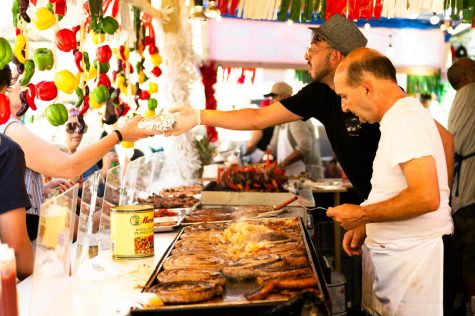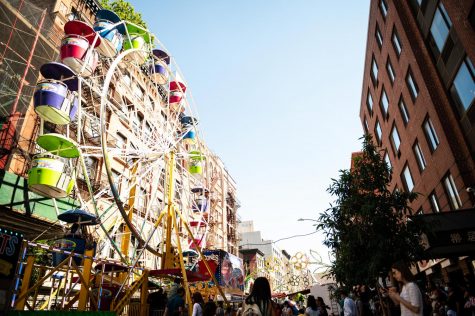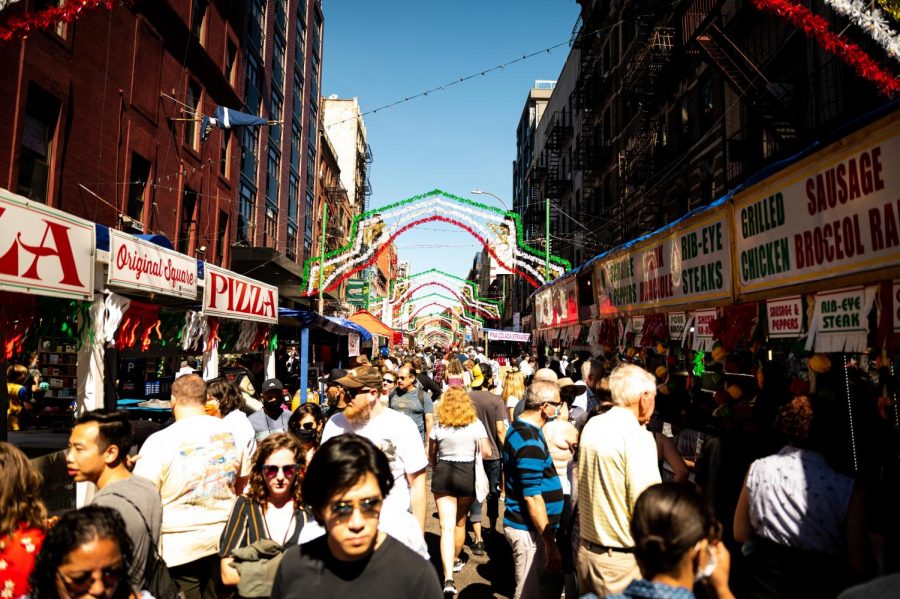The Feast of San Gennaro bodes ill for Little Italy
The shocking number of piña colada stations at the Feast of San Gennaro 2021 may reflect more than just a dying tradition.
Visitors crowd the Annual Feast of San Gennaro, held in Little Italy. Despite the name of the neighborhood, the Italian population in Little Italy has been decreasing and replaced by white collar workers. (Staff Photo by Jake Capriotti)
September 21, 2021
As a student dorming at Broome Street Residential College, right by Little Italy, I felt obligated to join in the crowd for the Feast of San Gennaro. I’d walked home the previous night on Mulberry Street, where all the action would be, under glistening red, white and green lights. I hoped the festival would give a somewhat authentic Italian experience.
You know it didn’t.
What began as a one-day block party in 1926 honoring Saint Januarius, the patron saint of Naples, has become a messy and tasteless 11-day tourist attraction with only a hint of Italian spirit. The Society of San Gennaro Naples’ and Suburbs Inc., an ostensibly non-profit organization, hosted the festival for 68 years until it was accused of mob influence and corruption in 1996. Its ownership was banned and transferred to Figli di San Genno Inc., which has since been on a mission to “save the feast” in terms of finance and management.

However, in seeking to attract more money, the festival has become a tourist trap. Instead of cannoli and zeppole, fried oreos festered. Instead of Campari and bellinis, piña coladas filled the street. Instead of carbonara and lasagna, tacos monopolized the scene. And I’m sure there’s a link between Republican mayoral candidate Curtis Sliwa’s visit to the festival and my struggle to find a sausage and peppers vendor without a MAGA hat. The organizer announced a Frank Sinatra tribute that day, but I wasn’t able to find the concert even after an hour of walking up and down Mulberry Street. Near the end of the feast, the humbly-sized statue of Saint Januarius presided over the official merch station.
Festival aside, Little Italy itself has become more little and less Italian than ever before. Historically, the neighborhood was home to tens of thousands of immigrants, most of them poor, and spanned 50 blocks from Houston to Worth Street at its start in the late 19th century. Today, it’s been reduced to a three-block area that houses an unclear number of Italians; in 2010, zero residents were born in Italy.
You must be wondering who is living in Little Italy now, if not Italians. The answer is white-collar workers with an average annual income of $278,448. These people are why rent has been increasing at more than twice the previous rates for historic restaurant owners. These people are why boutiques are replacing the pizzerias. These people are part of why the Feast of San Gennaro is as disappointing as it is today. And these people include us — Broome residents, and by extension, all NYU students.
For those of you who don’t know, NYU happens to be the wealthiest private landowner in New York City and the second-largest owner by number of addresses held, according to 2016 data. NYU added Broome to its portfolio in 2005 because it’s located in “the historic Little Italy and trendy SoHo neighborhoods.” The property is currently priced at $9,439,200, a small fraction of NYU’s $2 billion-worth of real estate, but acquiring it is a big step in the university’s journey toward gentrifying every Lower Manhattan neighborhood.
Even in its main role as an educational institution — rather than, you know, a real estate investor — NYU has not done enough to teach its students about gentrification and their participation in it. The university-sponsored and funded events, specifically at the other residence halls, should be aimed more at giving back to the communities that they are displacing. After all, it’s not just Little Italy that NYU is gentrifying but every neighborhood its reach extends to.
But then again, hall snacks are fun, fried Oreos are good and the decrepit Ferris wheel turned out to be magnificent. If you’re sick of Olive Garden, the Feast of San Gennaro provides the same quality and runs until Sunday Sept. 26.

Contact Alex Tran at [email protected].





























































































































































